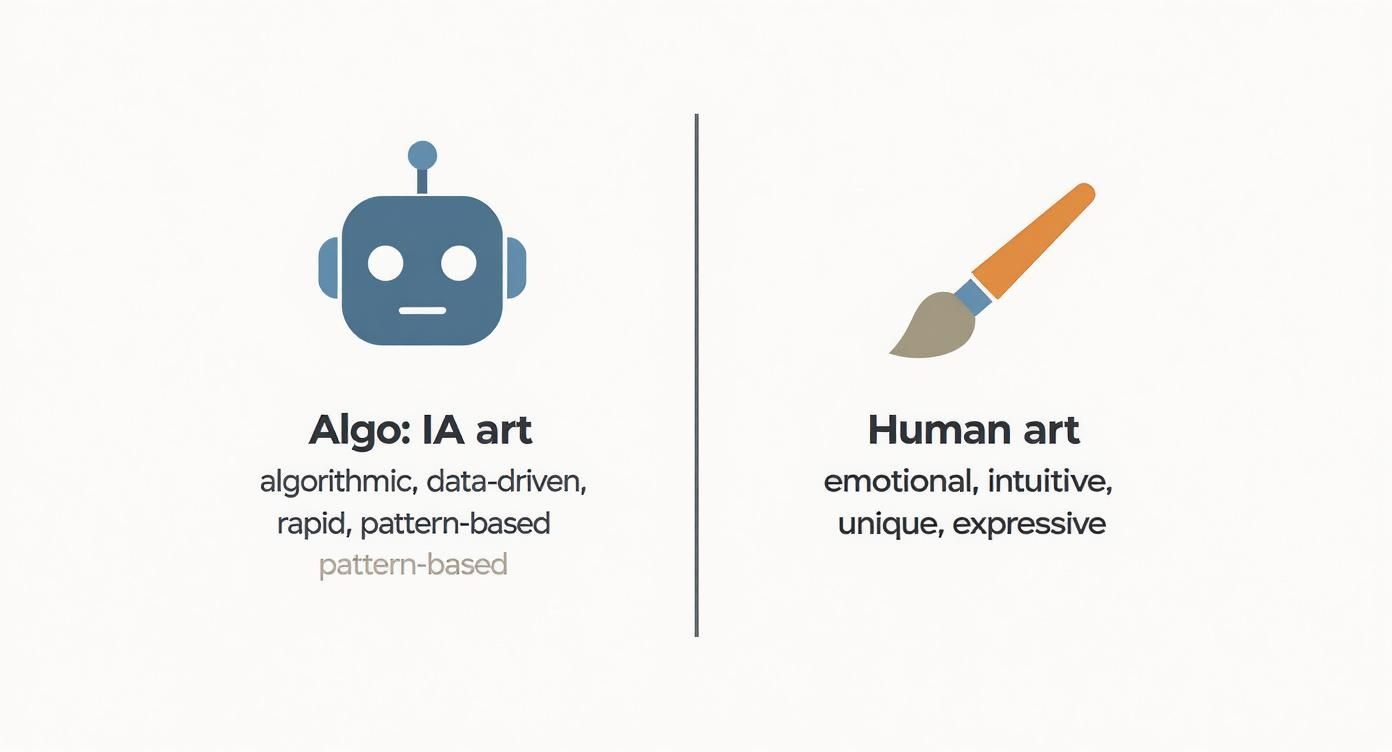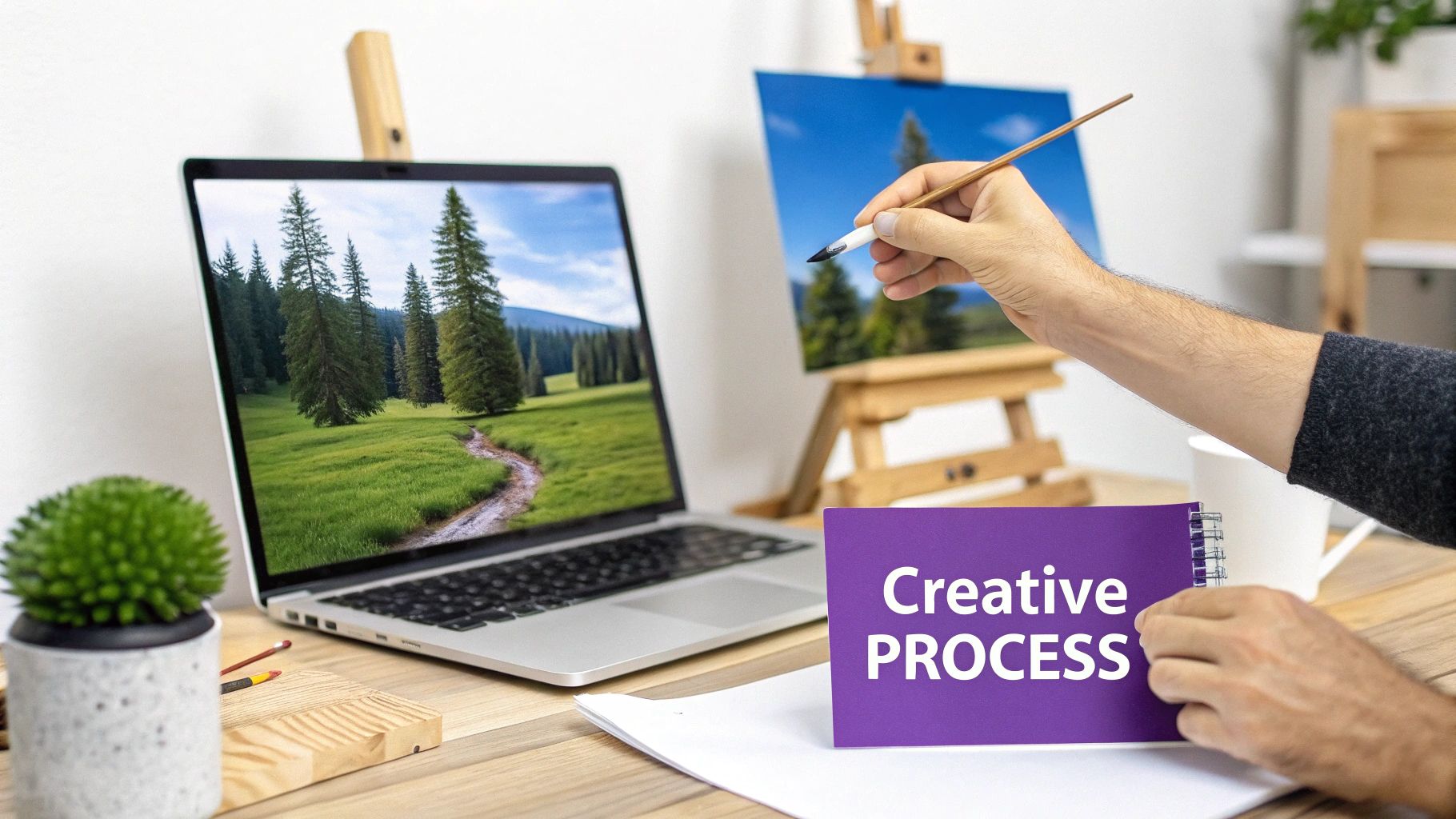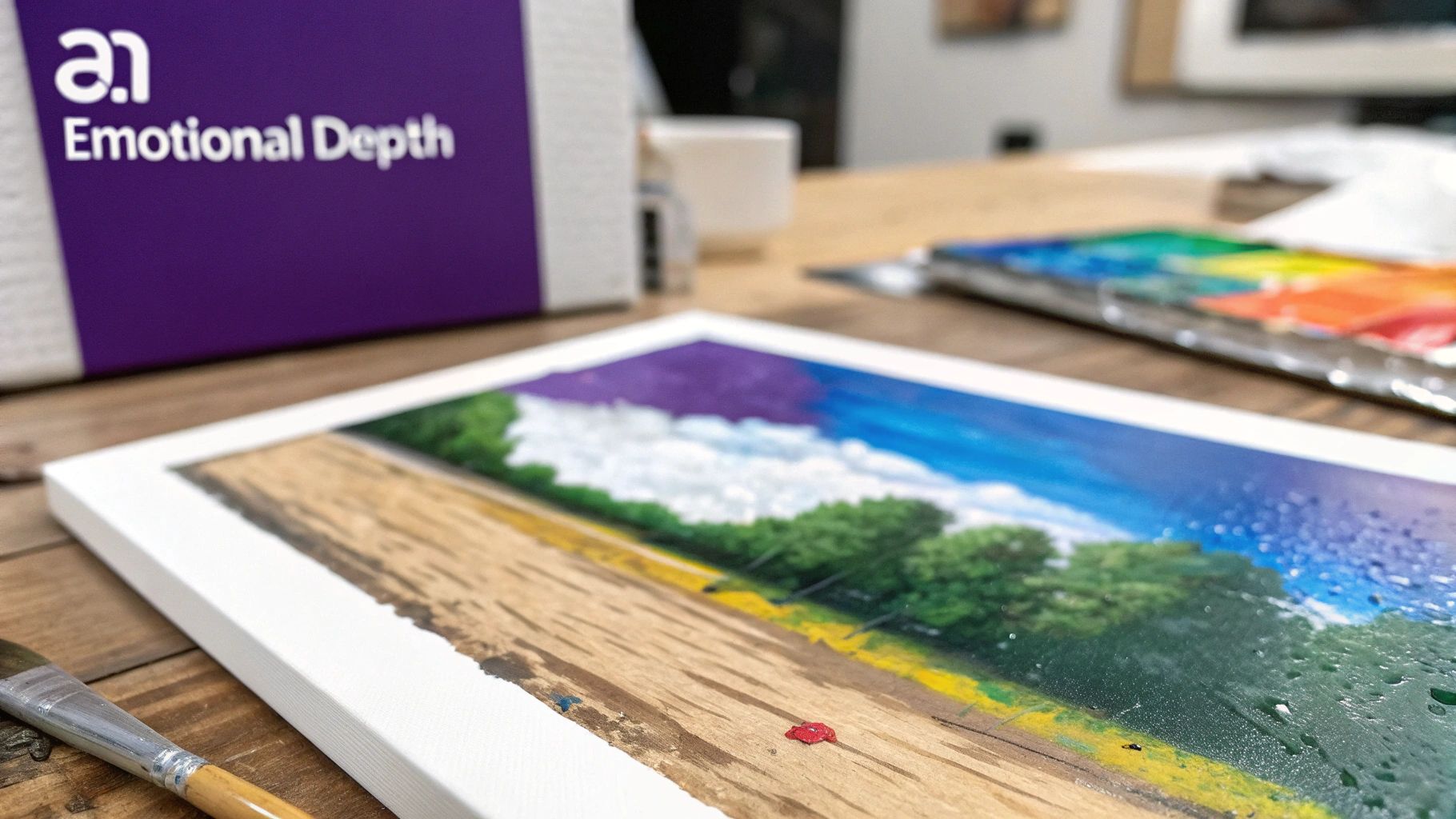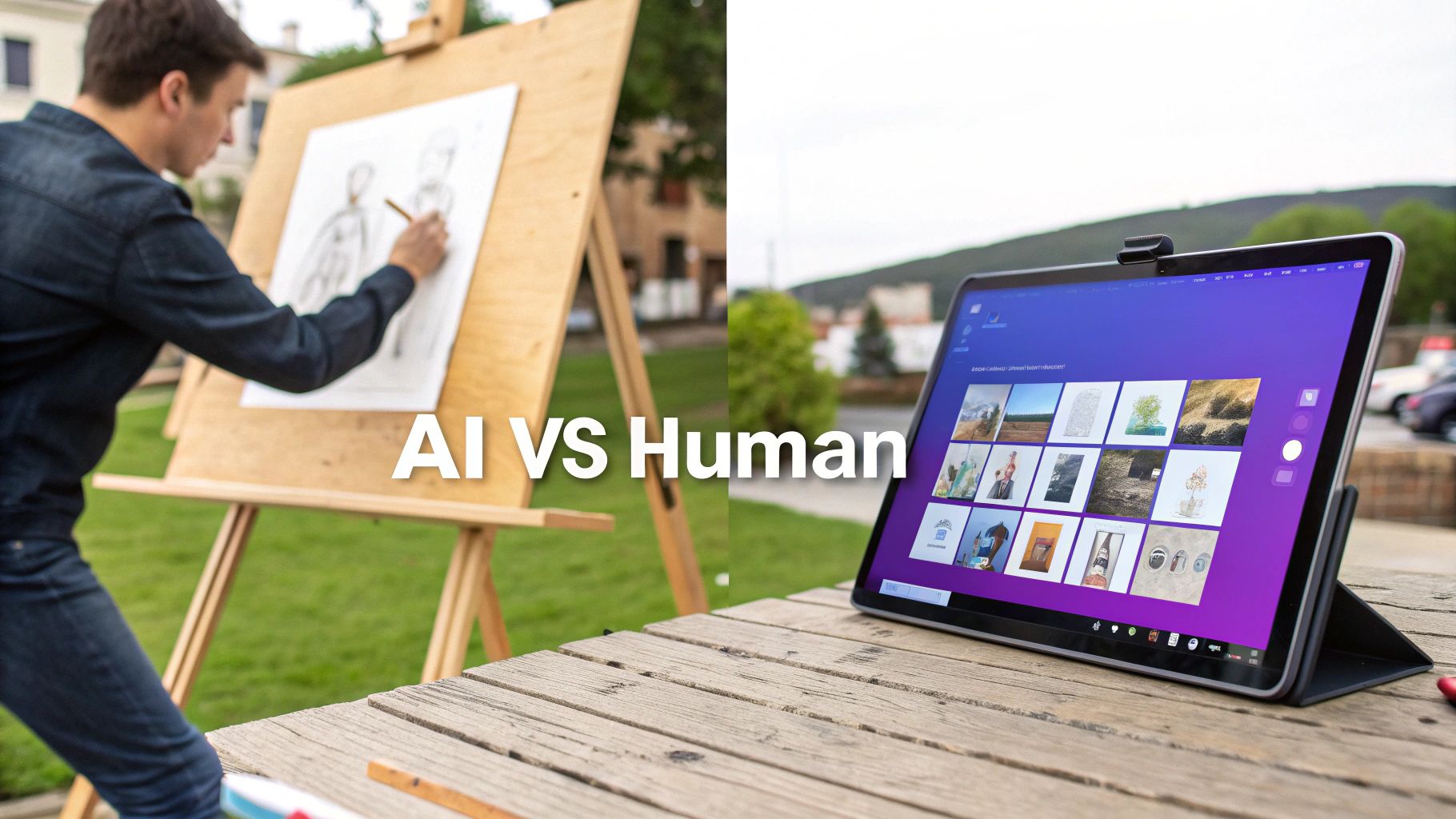AI Art vs Human Art The Definitive Guide
When you get down to it, the AI art vs human art discussion really boils down to intent versus process. Human art is the direct result of someone’s unique experience, skill, and emotion. On the other hand, AI art is the output of complex algorithms trained on massive datasets, making it incredibly fast and great at mimicking styles. Which one is "better" really depends on what you need—emotional connection or pure speed and volume.
Defining the Modern Creative Landscape
To really get into this comparison, we need to be clear on what we're talking about. Human-created art is a journey of discovery. It’s shaped by an artist’s life, their years of practice, and the deliberate choices they make. Every brushstroke or pixel placed is infused with their perspective, technical skill, and personal history.
AI art, however, is more of a collaboration between a person and a machine. It's all about prompt engineering and tweaking the output. If you want to dive deeper into the mechanics, understanding What is AI generated content? in a general sense is a great starting point. The skill isn't in the physical creation, but in guiding the algorithm to produce the desired result.
AI Art vs Human Art At a Glance
Let's break down the core differences in a simple table. This gives a high-level view before we dig deeper into each aspect.
| Attribute | AI Art | Human Art |
|---|---|---|
| Creative Process | Generates visuals based on text prompts and existing data. | An intentional act rooted in personal experience and emotion. |
| Skill Required | Crafting effective prompts and adjusting technical settings. | Deep knowledge of a medium, composition, and color theory. |
| Emotional Depth | Can simulate emotion by pulling from learned patterns. | Expresses genuine, lived emotional experiences. |
| Speed & Scalability | Incredibly fast, capable of producing limitless variations. | A much slower, methodical process where each piece is one-of-a-kind. |
| Authenticity | Always derivative, as it reinterprets existing data. | Truly original, born from a unique human viewpoint. |
This quick comparison shows that while both can produce stunning visuals, their origins and the "soul" behind them are fundamentally different.
This infographic does a great job of summarizing the main characteristics of each approach.

As you can see, the visualization drives home the point: AI is a master of speed and synthesis, while human art's strength lies in its emotional and experiential foundation. This brings up the critical questions of originality and provenance. More and more, people want to know where a piece of art came from, which is why checking your images for authenticity is becoming an essential skill for everyone.
Comparing the Creative Process
The path from an empty canvas to a final masterpiece is where you can really see the profound differences between human and AI creation. For a human artist, making art is an exploration. It’s a messy, beautiful journey tied to their own history, years of honing their craft, and deliberate, often emotionally charged, decisions. It's a space where a "happy accident" can become a stroke of genius and a unique viewpoint is the most precious tool in the box.
AI creation, on the other hand, is more of a dance between human and machine. The entire process hinges on prompt engineering, tweaking parameters, and refining what the algorithm spits out. Here, the skill isn't about the delicate touch of a brush but about translating a vision into precise text and technical commands.

Intent and Storytelling in Practice
Let's break this down with a real-world example. Imagine the task is to create a "serene forest landscape."
A human painter might tap into a memory of a morning hike—thinking about how the light cut through the canopy or the damp smell of moss. Every brushstroke is a choice, a layer of color and texture meant to capture a feeling. Their personal story and connection to that moment are woven directly into the fabric of the painting.
Someone using an AI tool takes a completely different route. They start by crafting a detailed prompt: "serene forest landscape, morning mist, sunbeams filtering through ancient redwood trees, photorealistic, cinematic lighting." From there, it's a process of refinement. They might add negative prompts to get rid of weird artifacts or adjust settings to dial in the right style. The final image is the algorithm’s best guess, built from analyzing millions of images tagged with similar keywords.
"Humans interpret subjectively, AI computes objectively. Comparing Human Creativity to Machine Learning, in my opinion is incorrect. At best, it comes from an uninformed place, at worst done so to mislead and/or excuse potential harm."
- Karla Ortiz, Professional Artist
This quote from a professional artist really gets to the heart of it. The AI can produce something technically flawless and visually striking, but it's based on data. The human artist creates a piece that carries a personal narrative and authentic emotion.
Viewer Perception and Artistic Value
How the art is made also changes how people see it. An interesting experimental study discovered something fascinating: while people generally preferred human-made art, they still picked the AI-generated pieces nearly 45% of the time when they didn't know which was which. This shows that AI is getting good enough to hold its own on aesthetics alone.
But here's the kicker: when asked to put a price tag on the art, people consistently valued the human-created pieces higher. This reveals the premium we still place on human intention, skill, and the story behind the work. You can dive deeper into these findings by checking out the full research on art perception.
When we talk about AI art vs human art, the conversation almost always lands on one key element: emotional connection. It’s the one thing technology hasn't quite managed to replicate. The real power of human art is that it comes from a place of lived experience. An artist is, in essence, pouring their own history, their joy, their pain, and their unique perspective onto a canvas, creating a direct line to the viewer's own heart.
This bond isn't just about what the final image looks like; it's about the story behind it. The artist’s struggles, their moments of triumph, and their particular way of seeing the world are all baked into the work. It creates a layer of authenticity that just hits differently. You're not just looking at a picture; you're connecting with a piece of someone's soul.

Simulated Feeling vs. Genuine Expression
Let's be clear: AI-generated art can absolutely make you feel something. By crunching massive datasets, it gets very good at knowing which combinations of colors, shapes, and subjects tend to trigger feelings like happiness, sadness, or awe. The results can be visually stunning and even emotionally powerful. But at its core, it's a calculated simulation, not a genuine expression.
An AI doesn't have a consciousness. It has no memories, has never felt heartbreak, and has never experienced the thrill of a new discovery. The emotion it produces is a mirror, reflecting the patterns it has learned from all the human art it was trained on, not an original feeling of its own.
"Artists bring their own technical knowledge, problem solving, experience, thoughts and lives into each artwork... as a human you are unique, and no matter how many images of others you see, it all goes through your own 'human filter' of knowledge, technique and life experiences."
- Karla Ortiz, Professional Artist
This quote from professional artist Karla Ortiz really gets to the heart of it. Human art is passed through a "human filter"—a lifetime of one-of-a-kind experiences that makes every single piece an irreplaceable statement. AI art, on the other hand, is a masterful remix of existing data, missing that personal filter that gives art its real emotional weight.
The Role of Intent in Art
Ultimately, the bedrock of authentic art is human intention. An artist makes deliberate, conscious choices to communicate a specific message or evoke a particular feeling. It's this intentionality that turns a simple image into a powerful story.
Think about where the emotion comes from in each case:
- Human Art: The process starts with a desire to communicate a personal truth, explore a complex idea, or work through a lived experience. Here, the emotion is the cause of the creation.
- AI Art: The algorithm generates visuals that are statistically likely to create an emotional effect in the viewer. The emotion is the intended outcome, not the origin.
While an AI can churn out technically perfect and beautiful images, it will always lack the fundamental "why" behind the work. The vulnerability and personal storytelling found in human art create a bond that an algorithm simply can't manufacture. When a project needs deep emotional resonance and an authentic story, the human touch isn't just better—it's essential.
Technical Skill vs. Algorithmic Precision
When we talk about AI art vs. human art, the very meaning of "skill" gets turned on its head. For a human artist, skill is something earned, the product of years—often decades—of relentless practice. It’s a deep, intuitive grasp of composition, color theory, anatomy, and the unique feel of a chosen medium, be it oil paint on canvas or a stylus on a screen.
This hard-won knowledge is then expressed through the beautifully imperfect filter of human experience. An artist’s distinctive brushstroke, their unique way of capturing light, or even their happy accidents become their signature. These aren't flaws; they are the fingerprints of an individual style that makes the work truly one-of-a-kind.
The Nature of AI Skill
An AI’s “skill,” on the other hand, is all about algorithmic precision. It doesn't practice like a person does. Instead, it pulls its abilities from a massive database, having analyzed millions of images to understand patterns, styles, and structures. It can mimic almost any artistic style with frightening accuracy, blending influences from countless sources to spit out a polished image in seconds.
The machine's power is its flawless execution. An AI can generate images with perfect perspective, mind-boggling detail, and impeccable lighting that might take a human artist days or weeks to get right. But this perfection often lacks that personal touch, that spark of soul that we see in the greatest human art.
"Artists look at other artists to learn how to solve some visual problems and be inspired, but that's as far as looking at other artists will get you. Artists bring their own technical knowledge, problem solving, experience, thoughts and lives into each artwork."
An AI can paint you a picture that looks just like a Van Gogh, but it can’t replicate the troubled genius and raw emotion that fueled his work. It can create a photorealistic portrait, but it misses the subtle choices a human photographer makes—capturing that fleeting, genuine expression based on empathy, not just data. The difference can be subtle, which is why it's becoming more important to understand what AI detectors look for to tell them apart.
Ultimately, it’s best to see AI not as a replacement for human skill, but as an incredibly powerful tool. It can help artists brainstorm, handle tedious technical tasks, and quickly prototype ideas. The real magic happens when an artist’s vision and earned expertise steer the AI’s precision, creating a true collaboration between human creativity and machine intelligence.
Navigating Copyright and Ethical Debates
The moment you start comparing AI art vs human art, you land squarely in a tangled mess of legal and ethical questions. Copyright is easily one of the biggest sticking points. When someone generates an image, who actually owns it? Is it the person who typed the prompt, the company that built the AI, or maybe the algorithm itself?
Right now, the law is playing catch-up. In the United States and many other places, copyright is something reserved for human creators. This leaves most AI-generated art in a legal no-man's-land, often defaulting to the public domain unless a human has significantly altered it.
Training Data and Artist Consent
The controversy really heats up when you look at how these AI models learn. They are fed millions upon millions of images pulled from across the internet—a massive dataset that includes countless copyrighted works from human artists, often used without permission or payment.
This has sparked a major backlash, including lawsuits from artists who feel their entire body of work is being mined to train a system that could make their own skills obsolete. The debate boils down to fairness and an artist's fundamental right to control their own creations.
This dynamic raises profound questions about labor, intellectual property, and what it means to create in an era where an algorithm can replicate a lifetime of artistic development in seconds. The ethical implications are significant for the entire creative industry.
Then there's the money. The explosion of AI art has created both new markets and serious disruptions. By the mid-2020s, it's estimated that AI-generated art already made up 5% of the contemporary art market, and some pieces were selling for thousands of dollars. But while some see a new collaborative tool, many traditional artists see a direct threat to their livelihood. You can read more about the rise of AI in the art world on tredence.com.
Forging an Ethical Path Forward
Finding a way through this new landscape is going to require a lot of careful thought. Artists and developers are already pushing for more ethical AI practices that put transparency and consent first.
A few of the ideas gaining traction include:
- Opt-in Training Datasets: Building AI models trained only on public domain images or on art from creators who have given their explicit permission.
- Compensation Models: Creating systems that pay artists a royalty when their unique style is used as a reference to generate new images.
- Clear Labeling: Adopting an industry-wide standard to clearly mark AI-generated content, so everyone knows what they're looking at.
As these conversations evolve, being able to tell machine-made from human-made art is becoming essential. Learning how to check if a photo is real is no longer just a neat trick; it's a critical piece of digital literacy for everyone. The future will almost certainly require a mix of new laws and shared ethical standards to make sure innovation doesn't steamroll human creativity.
When to Use AI Art vs Human Art

The big question isn't whether AI art is "better" than human art. It's about picking the right tool for the job. Your specific needs—things like budget, timeline, and the kind of connection you want to make with your audience—will point you in the right direction. Each has its own sweet spot.
AI art really comes into its own when you need visuals fast and in large quantities. It's a powerhouse for projects that demand quick turnarounds and cost-effective production.
Think about using AI art for things like:
- Rapid Prototyping: Need to mock up a website or app design in a hurry? AI can generate dozens of visual concepts in minutes.
- Concept Art: Brainstorming characters or environments for a game or film is incredibly fast with AI.
- Marketing Assets: You can create a steady stream of unique, royalty-free images for blog posts or social media feeds.
- Background Visuals: Need a bunch of abstract textures or simple scenic backdrops? AI can produce them at scale without breaking a sweat.
In these situations, the primary goal is getting the job done efficiently, not necessarily telling a profound emotional story.
When Human Art Is Non-Negotiable
On the flip side, if your project is all about a unique vision, emotional resonance, and a genuine human touch, then hiring an artist is the only way to go. This is the route you take when you need to forge a real connection with people.
Human art is the clear winner for:
- Fine Art Pieces: Creating a one-of-a-kind painting, sculpture, or print that holds intrinsic value and tells a story.
- Signature Brand Illustrations: Developing a completely distinct visual style that makes your brand instantly recognizable.
- Narrative-Driven Projects: Illustrating a children's book or a graphic novel where every brushstroke needs to convey feeling.
The core difference really comes down to the type of investment you're making. Human art is an investment in a singular perspective and authentic storytelling. AI art is an investment in speed and scalability. The key is to match that investment to your project's goals.
Of course, a major factor in this decision is the budget. We see this play out in discussions around the AI vs Traditional Photography Cost, where financial constraints often steer the choice. If your project hinges on a powerful, singular statement that has to hit people on an emotional level, the investment in a human artist will always pay off. But if the goal is to get functional, high-volume visuals out the door, AI is an incredibly practical and powerful tool.
Frequently Asked Questions
Digging into the AI art vs human art debate always brings up a few common questions. Let's tackle some of the big ones to clear up the distinctions for creators, art lovers, and anyone curious about where art is headed.
Is AI Art Considered Real Art?
That’s the million-dollar question, isn't it? Technically, an AI generates an image based on data and prompts. It doesn't have intent, emotions, or life experiences to draw from, which many people see as the very soul of art.
But if you define art by the feeling it creates in the person looking at it, then the answer gets a lot more complicated. An AI-generated image can absolutely be moving, beautiful, or thought-provoking. So, if art is purely about the final product and its impact, then yes, for many, it qualifies. It really boils down to where you believe the "art" happens—in the creator's mind or the viewer's eye.
Will AI Replace Human Artists?
It's highly unlikely. Think of AI as just the latest tool to enter the artist's studio, not a replacement for the artist. Photography didn't kill painting, and digital software didn't make traditional media obsolete. AI is much the same.
While AI is incredible at generating ideas and executing technical styles with lightning speed, it can't replicate a human's unique voice, emotional vulnerability, or the story behind a piece. Instead, we're seeing artists use AI as a powerful assistant for brainstorming, creating textures, or mocking up compositions. The future looks more like a partnership, with human creativity guiding the AI's capabilities.
Public sentiment seems to echo this idea of a careful partnership. A recent Pew Research Center survey found that while people are warming up to AI in daily life, 53% believe it will worsen people's ability to think creatively. This points to a real public concern about protecting what makes us uniquely human.
The study also showed a strong desire for transparency—people want to know if what they're looking at was made by a person or a machine. You can dive into the full findings on public perceptions of AI on pewresearch.org.
Ultimately, as AI's role expands, the value of genuine, human-made art will likely become even more cherished.
Ready to verify the authenticity of your images? Use the AI Image Detector for a fast, free, and private analysis. Check your image now.
